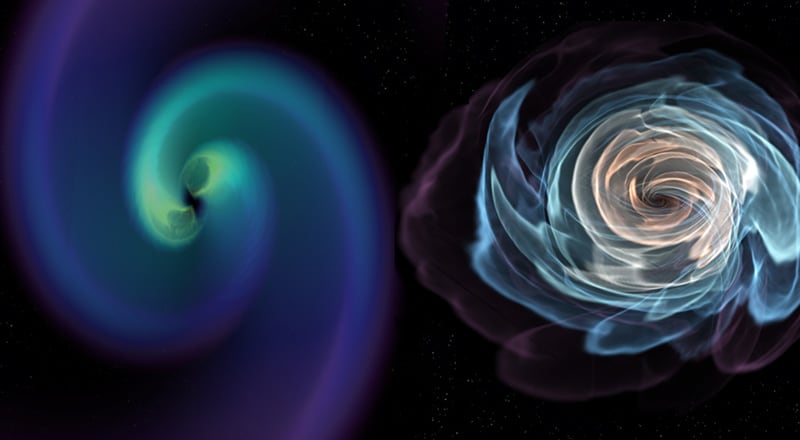A distant object that could be smallest known black hole, or the largest known neutron star, has been spotted by the LIGO–Virgo gravitational-wave detectors. The 2.6 solar-mass object appears to have merged with a 23 solar-mass black hole, creating gravitational waves that were detected here on Earth in August 2019. Unlike a previously observed merger between two neutron stars, no electromagnetic signal was observed. At nearly 9:1, the ratio of masses of the two objects is the greatest ever detected by LIGO–Virgo.
LIGO and Virgo are three huge interferometers – two in the US and one in Italy – that have detected gravitational waves from the mergers of black holes and neutron stars for nearly five years.
Neutron stars and stellar black holes are the final stages of evolution for large stars – with black holes being more massive than neutron stars. In theory, the maximum mass of a neutron star is about 2.1 solar masses. However, there is some indirect evidence that more massive neutron stars could exist. There is little evidence for the existence of black holes smaller than about 5 solar masses, leading to a mass gap in our observations of these compact objects.
Record breaking
What is intriguing about the August 2019 merger – dubbed GW190814 – is the mass of the smaller object, which appears to fall within this gap. “Whether any objects exist in the mass gap has been an ongoing mystery in astrophysics for decades,” says Charlie Hoy of the UK’s Cardiff University, who played a key role in analysing data from the detection and writing the paper that describes the observation, which has been published in The Astrophysical Journal Letters. “What we still don’t know is whether this object is the heaviest known neutron star or the lightest known black hole, but we do know that either way it breaks a record.”

Spectacular collision of two neutron stars observed for first time
LIGO Scientific Collaboration spokesperson Patrick Brady at the University of Wisconsin, Milwaukee adds, “This is going to change how scientists talk about neutron stars and black holes. The mass gap may in fact not exist at all but may have been due to limitations in observational capabilities. Time and more observations will tell.”
According to LIGO team member Vicky Kalogera of Northwestern University in the US, the large mass ratio will encourage astrophysicists to rethink models of how such binary compact objects form. “It’s a challenge for current theoretical models to form merging pairs of compact objects with such a large mass ratio in which the low-mass partner resides in the mass gap,” she says.
I think of Pac-Man eating a little dot
Vicky Kalogera
Unlike the merger of two neutron stars that was observed by LIGO–Virgo in 2017, no electromagnetic radiation was detected with the gravitational waves of GW190814. According to LIGO-Virgo scientists there are three possible explanations for this. One is the great distance to where the merger occurred – 800 million light-years – which is about six times the distance as the 2017 neutron-star merger. Another possibility is that both objects were black holes, and no electromagnetic radiation has been detected from any black-hole mergers spotted by LIGO–Virgo. A third possible explanation is that the neutron star was “swallowed whole” by the black hole in such a way that no radiation was emitted.
“I think of Pac-Man eating a little dot,” quips Kalogera, adding “When the masses are highly asymmetric, the smaller neutron star can be eaten in one bite.”
The above video is a visualization of the period leading up to the GW190814 merger, showing the two objects and the gravitational waves they emitted.
https://news.google.com/__i/rss/rd/articles/CBMiXWh0dHBzOi8vcGh5c2ljc3dvcmxkLmNvbS9hL215c3Rlcnktb2JqZWN0LXNwb3R0ZWQtYnktbGlnby12aXJnby1ncmF2aXRhdGlvbmFsLXdhdmUtZGV0ZWN0b3JzL9IBAA?oc=5
2020-06-24 11:44:15Z
52780873763761
Tidak ada komentar:
Posting Komentar